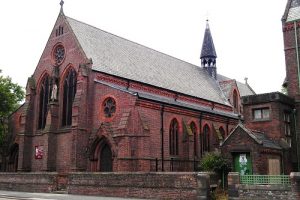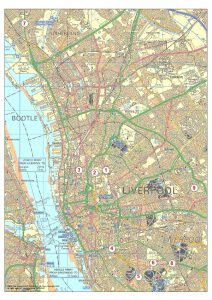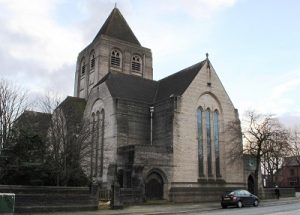By Ian Simpson*
Liverpool is a city which has many wonderful buildings. These include Georgian townhouses, industrial workhouses and an increasing number of bright and shiny modern developments.

Photo by Marcus Cramer
It is also well known for its two Cathedrals; the monumental and formal looking Anglican Cathedral, Britain’s biggest Cathedral and the modernist Roman Catholic Metropolitan Cathedral of Christ the King, totally different but just as beautiful.
But Liverpool’s religious heritage has much more to offer than these two spectacular showcase buildings. Prime amongst the most important religious buildings are the churches funded and designed by the Horsfall family.

St Margaret Of Antioch Toxteth
Charles Horsfall was born in Yorkshire in 1776. Aged 16 he sailed to Jamaica, establishing himself as a commodities trader and becoming wealthy. Returning to England around 1803 he took up residence in Everton (north of Liverpool city centre) where, in 1813, he subscribed to the fund to construct the church of St. George. This church was revolutionary, being the first of Liverpool’s four “cast iron churches”, designed by James Cragg and Thomas Rickman. The interior is built entirely of cast iron whilst the exterior is faced in sandstone; the large slate roof panels sit directly upon the iron frame.
Christ Church (Great Homer Street)
When Charles Horsfall died in 1846 his 13 children, led by his son Robert, founded Christ Church, Great Homer Street, in his memory. The noted architect E.H. Shellard was employed to design what by all accounts was a fine church. Historian James Picton (1873) described it as “a very excellent reproduction of a parish church of the fifteenth century… executed in white stone”. Sadly it did not survive the May Blitz of 1941; no trace of it remains today.
Robert Horsfall was a successful stockbroker who, in later life, became heavily influenced by the Tractarian (Anglo-Catholic) movement within the Church of England. He founded the small church of St. James-the-Less in 1869 for the Tractarians of Kirkdale, a working-class area of north Liverpool. This too was lost in the May Blitz.

See below for key to map
St. Margaret of Antioch
Robert commissioned George Edmund Street – who is perhaps today best known for London’s Royal Courts of Justice – to build the church of St. Margaret of Antioch on Princes Road, Toxteth. Consecrated in 1869, the exterior of this simple but attractive brick church holds no clue as to the glories within.
It is difficult to do justice in words to the interior decoration scheme at St. Margaret’s. Practically every square centimetre of wall and ceiling is included within a carefully-designed scheme of paintings and geometrical designs. The chancel ceiling features a host of angels, each with their own musical instrument, in 14th-Century style. There is some excellent stained glass here, including some 1952 work by Nicholson which replaced windows destroyed in WWII. Thankfully the rest of the church came through the War intact; it also survived civil unrest (the “Toxteth Riots”) in 1981 undamaged.
Robert Horsfall died in 1881 and is commemorated in a memorial brass in the chancel of St. Margaret’s.
During the late 19th Century there were tensions between the Tractarian and Evangelical parties within the Church of England, and perhaps nowhere were these more evident than in Liverpool. Many families, the Horsfalls included, had members on both sides of this theological divide. George Horsfall, a younger brother of Robert, was on the other side of the Church of England’s religious divide and was staunchly Evangelical.
Christ Church (Toxteth Park)
George Horsfall founded Christ Church in Toxteth Park, a short distance from St. Margaret’s, in 1871. Local architects Culshaw and Sumners were engaged to design this large, highly complex and somewhat eccentric building whose tall, bowed broach spire is visible for several kilometres across South Liverpool. Christ Church contains some very good 20th Century work by local craftsmen, including a stained glass window by Gustave Hiller showing Liverpool’s Anglican Cathedral under construction. The reredos and chancel floor are the work of renowned Liverpool ecclesiastical architect Bernard Miller.
St. Agnes’ Church
Upon Robert Horsfall’s death his son Douglas Horsfall decided to build a church in his memory and “which would most readily bring a man to his knees”. Continuing the family tradition of engaging nationally-known architects, he commissioned John Loughborough Pearson to build a scaled-down version of his design for Truro Cathedral on a site in Toxteth Park about 500m from Christ Church.
St. Agnes’ Church was consecrated in 1885 when Douglas was just 29. The similarities with Truro Cathedral are invisible from outside, the exterior being of red Ruabon brick, but upon entering the church they become obvious – the Caen stone interior with its quadripartite rib-vaulting is quite glorious. St. Agnes’ cost £28,000 to build, equivalent to about £3,000,000 today.
Douglas Horsfall’s youth meant that he had many opportunities throughout his life to add to the church. He commissioned the sculptured frieze above the apse in memory of his brother Charles in 1893; based on Van Eyck’s “Adoration of the Lamb”, this was executed by Nathaniel Hitch who carved the reredos of Truro Cathedral. In 1935 he added the West window (featuring his father as St. Chad) to honour the church’s 50th anniversary.
St. Faith’s
St. Agnes’ was not to be Douglas Horsfall’s only Liverpool church. He founded St. Faith’s, Great Crosby, as a spiritual home for the Anglo-Catholics in the north of the city, in 1900. The reredos here is by Salviati of Venice; its depiction of the Crucifixion was denounced as “Popish” by the Evangelicals of the day as factionalism within the Anglican Church continued to simmer.
Douglas also founded the small Chapel of St. Pancras, Sefton Park, in 1906, as a daughter church to nearby St. Agnes’. The dedication is significant as both Agnes and Pancras were child martyrs. St. Pancras’ closed in 1937 and served as the assembly hall for Lidderdale Road School until demolition in 2003.
St. Paul
The final Horsfall church was something completely different. St. Paul, Stoneycroft, was paid for by Douglas Horsfall and designed by Giles Gilbert Scott. Consecrated in 1916, this looming, vast grey edifice is Europe’s largest brick-built church (with over two million bricks) and the only Horsfall church to feature reinforced concrete. Scott used the project as a “test bed” to try out some of his ideas for Liverpool’s Anglican Cathedral.

St Paul Stoneycroft
Heritage At Risk
Of the nine churches partially or wholly funded by the Horsfalls six survive. Four of these pose serious and interesting challenges to conservators and are on Historic England’s “Heritage At Risk” register.
Christ Church poses particular problems. Its complex roof structure has made maintenance difficult; in tandem with poor detailing to the rainwater goods this has led to water ingress over the years resulting in dry rot to the roof timbers. A proposal to carry out urgent remediation works is in development and will hopefully proceed in 2018.
A programme of repair works at St. Agnes’ started in March 2017. As well as renewing the south slopes of the roof, some potentially dangerous high-level stonework will be repaired. Some interior stonework and flooring repairs will also be carried out. As part of the preparation for this project a drone survey of the roof was commissioned. This provided invaluable high-definition pictures at a tenth of the cost of hiring a “cherry picker” to take a surveyor up to roof level.
Some cracks appeared within the interior (Caen stone) walls about three decades ago. These were pointed-up in an ugly grey mortar mix at the time but no further action was taken. In the run-up to the current project it was noted that some of these cracks had opened up again, suggesting live movement within the structure, and an urgent investigation was carried out. It was found that the cracks (which did not appear on the external walls) were caused by thermal expansion and contraction of the limestone. A monitoring system is to be introduced which will record atmospheric conditions within the church and inside the walls and then, by computer analysis, correlate these to any future movement. Once the mechanism is fully understood, a solution can be designed and implemented to prevent further cracking.
The newest Horsfall church, St. Paul’s, has been the most problematic. Repairs carried out in 1998 were only partly successful, and by 2013 the flat reinforced concrete roofs incorporated into the brick structure were showing signs of serious decay. The steel reinforcements had failed due to concrete carbonation and water ingress.
These structural problems combined with the cost of heating and a declining congregation led to the abandonment of St. Paul’s in 2014. In April 2017 the building was acquired by the Coptic Orthodox Church which has ambitious plans to repair the building and improve its community facilities.
The surviving Horsfall Churches, built over a period of about a century, are all fascinating buildings in their own right. Together they tell the story of how church design progressed through the 19th Century and of how one family of philanthropists devoted their wealth to the architectural and spiritual development of the city of Liverpool. It is surely right that continued effort and resources should be devoted to conserving these churches for future generations to enjoy.
Key to map:
1. St. George, Everton
2. Christ Church, Great Homer Street
3. St. James-the-Less, Kirkdale
4. St. Margaret of Antioch, Toxteth
5. Christ Church, Toxteth Park
6. St. Agnes, Toxteth Park
7. St. Faith, Great Crosby
8. St. Pancras, Sefton Park
9. St. Paul, Stoneycroft
My thanks to Mrs Kim Stanley of the Diocese of Liverpool for producing the map
Bibliography:
Lewis, D. (2000) – The Churches of Liverpool. (Bluecoat Press)
Pevsner, N. (1969) – The Buildings of England: South Lancashire. (Penguin Books)
Picton, J. A. (1873) – Memorials of Liverpool, Historical and Topographical, including a History of the Dock Estate. (Longmans, Green & Co.)
Simpson, I. (2014) – The Parish Church of St. Margaret of Antioch, Toxteth. (St. Margaret’s Church)
* Ian Simpson is the Heritage Officer for the Diocese of Liverpool, a position funded by Historic England as part of the Places of Worship Support Officers programme and has been involved in the care and conservation of historic buildings for several years. He is also a Trustee of the Churches Visitor and Tourism Association, the only UK-wide cross-denominational forum dedicated to best practice in welcoming visitors to churches. In his spare time Ian enjoys travel, photography and the occasional drop of beer.
Ian welcomes correspondence (in English, Spanish or Portuguese) at ian@iansimpson.eu and his website is at www.iansimpson.eu





Follow us: